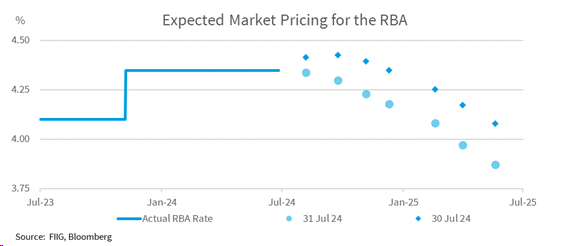by
Philip Brown, Head of Research | Aug 01, 2024
The 2Q CPI was high, but not quite as bad as feared. The headline inflation rate rose 1.0% in the quarter and 3.8% on the year. The trimmed mean rose 0.8% in the quarter and 3.9% on the year. That was broadly in line with the RBA’s forecasts, which were for a 3.8% annual rise for both. The mix of contributors showed housing again a key driver (+1.1% QoQ), with food and non-alcoholic beverages also material (+1.2%). You can slice and dice the inflation data lots of different ways, but the main conclusion doesn’t change: it probably wasn’t high enough to force the RBA’s hand next week. The RBA will almost certainly discuss raising the cash rate, but is now much more likely to decide to leave rates on hold. The trajectory of inflation back towards the 2.5% target is just about on track – if you squint – and so the RBA will probably leave rates unchanged. Markets, however, concluded that the RBA couldn’t possibly decide to sit on their hands and immediately switched from a risk of a rate rise to a risk of a rate cut. It’s true that the 3Q CPI print will include various government subsidies that lower the headline rate. But there will also be the full effect of pay rises and tax cuts coming the other way.

The growing belief that the RBA will be cutting rates by November seems overly adventurous to us. Markets have a long history of failing to price “no change” from central banks. For example, the pricing of the Federal Reserve has been anticipating rate cuts for the entire year (see chart below) and the RBA is deliberately choosing a longer slower pattern for rate moves. The RBA is choosing to forego the last couple of rate rises to preserve labour market gains, but this will cause a longer peak. Even if the FOMC starts cutting rates soon, that doesn’t force the RBA to follow suit.

Source: FIIG, Bloomberg
And yes, we know that the Bank of Canada already cut rates, but the BoJ has just raised them. Different central banks look more to their own economies and less to each other than generally understood. (And, for those keeping track, the current unemployment rate in Canada is 6.4% - so the situation is materially different.)
The RBA (and mortgage holders) can probably breathe a sigh of relief. Inflation is proving a little bit sticky but it was expected to be a little bit sticky. It’s looking more and more like 4.35% is the top of the RBA cycle. The RBA is unlikely to be quite so unequivocal when they meet next week, but with the labour market and other measures slowly weakening the window for further rate increases is passing – and very nearly fully passed. Other Central Banks will be cutting rates soon and the RBA will, eventually, join them.